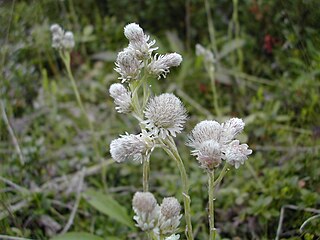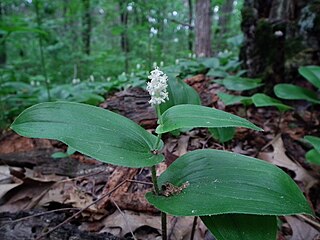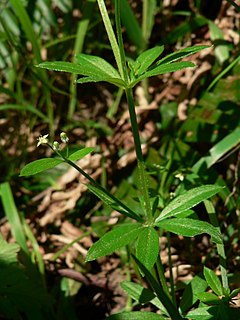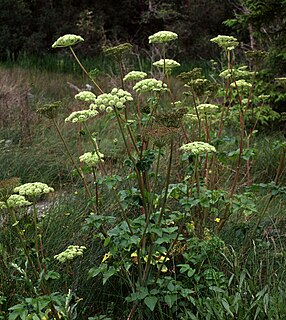
Antennaria alpina is a European and North American species of plant in the family Asteraceae. Antennaria alpina is native to mountainous and subarctic regions of Scandinavia, Greenland, Alaska, and the Canadian Arctic, extending south at high altitudes in mountains in the Rocky Mountains south to Montana and Wyoming.

Primula sect. Dodecatheon is a section of herbaceous flowering plants in the family Primulaceae. Primula species in this section were formerly placed in a separate genus, Dodecatheon. The species have basal clumps of leaves and nodding flowers that are produced at the top of tall stems rising from where the leaves join the crown. The genus is largely confined to North America and part of northeastern Siberia. Common names include shooting star, American cowslip, mosquito bills, mad violets, and sailor caps. A few species are grown in gardens for their showy and unique flower display.

Maianthemum canadense is an understory perennial flowering plant, native to Canada and the north-eastern United States, from Yukon and British Columbia east to Newfoundland, into St. Pierre and Miquelon. It can be found growing in both coniferous and deciduous forests. The plant appears in two forms, either as a single leaf rising from the ground with no fruiting structures or as a flowering/fruiting stem with 2-3 leaves. Flowering shoots have clusters of 12–25 starry-shaped, white flowers held above the leaves.

Galium triflorum is a herbaceous plant of the family Rubiaceae. It is widespread in northern Europe, eastern Asia and North America. The plant is considered a noxious weed in New York, Pennsylvania, Vermont, New Hampshire, Connecticut and Massachusetts.

Primula pauciflora, the pretty shooting star, few-flowered shooting star, dark throat shooting star or prairie shooting star, is a species of flowering plant in the primula family Primulaceae. It is a widespread and very variable species, native to western North America, from Subarctic America to Mexico, often in xeric and desert habitats. It is found in the Great Basin Deserts and Mojave Desert. Its synonyms include Dodecatheon pauciflorum and Dodecatheon pulchellum.

Angelica lucida is a species of angelica known by the common names seacoast angelica and sea-watch. It is also one of many species in the celery family which are casually called wild celery.

Alf Erling Porsild (1901–1977) was a Danish-Canadian botanist.

Primula conjugens, synonym Dodecatheon conjugens, is a species of flowering perennial plant in the primrose family, known by the common name Bonneville shooting star.

Primula fragrans, synonym Dodecatheon redolens, has the common name scented shooting star. It is a species of flowering plant in the primrose family.

Erigeron peregrinus is a North American species of flowering plants in the family Asteraceae known by the common name wandering fleabane.

Agoseris aurantiaca is a species of plant in the family Asteraceae, commonly called orange agoseris or mountain dandelion. It is widespread and common in western North America from Alaska and the Northwest Territories in Canada southward to California, Arizona, and New Mexico, and eastward as far as the Rocky Mountains and the Black Hills. There are also isolated populations in the Chic-Choc Mountains on the Gaspe Peninsula and in the Otish Mountains of central Quebec.
Erigeron muirii, or Muir's fleabane, is a rare Arctic species of flowering plant in the family Asteraceae. It has been found only in northern Alaska and the northern Yukon Territory, including Herschel Island in the Arctic Ocean. It grows in tundra, dry slopes, and rock outcrops.

Galium trifidum is a species of flowering plant in the coffee family, known by the common name three-petal bedstraw. It grows widespread in the arctic, temperate and subtropical regions of the Northern Hemisphere: northern and central Asia, northern and eastern Europe and much of North America.
Wilhelmsia is a monotypic genus of plants in the family Caryophyllaceae. It contains only one species, Wilhelmsia physodes, native to Alaska, northern Canada, and Russia.
Minuartia yukonensis, the Yukon sandwort or Yukon stitchwort, is a plant species native to Yukon and Northwest Territories of Canada, as well as Alaska, and The Russian Far East. Flora of North America and some other publications also report it from British Columbia, but more recent work shows those collections to have been misidentified. Minuartia yukonensis grows in dry, rocky meadows at elevations less than 1000 m.
Salix commutata, the undergreen willow, is a plant species native to western Canada and the northwestern United States. It has been reported from Alaska, Yukon, the Northwest Territories, British Columbia, Alberta, Saskatchewan, Montana, Idaho. Washington and Oregon. It grows on rocky alpine and subalpine slopes, conifer forests, stream banks, bogs, etc.
Kobresia sibirica, the Siberian bog sedge, is a plant species known from arctic and alpine tundra in Siberia, the Russian Far East, Alaska, Yukon, the Canadian Northwest Territories, Nunavut, British Columbia, Colorado, Utah, Montana, and Wyoming. Some authorities have considered the North American collections as distinct species, but they are more often tentatively regarded as conspecific with K. siberica, but this is pending further investigation.
Antennaria friesiana, or Fries' pussytoes, is an Arctic species of plants in the family Asteraceae. It is the northern reaches of Asia and North America. Many of the populations lack male (staminate) flowers and reproduce asexually.

Antennaria monocephala, the pygmy pussytoes, is a flowering plant in the family Asteraceae. It is native to arctic and alpine regions of North America as well as the Chukotka (Chukchi) Peninsula of Russia.

Primula frenchii, French's shootingstar, is a species of flowering plant in the family Primulaceae. It is native to the central and southern United States, in southern Illinois, Indiana, Kentucky, Arkansas, and Alabama. It grows in moist, shady areas such as ledges near streams and under sandstone cliffs.














